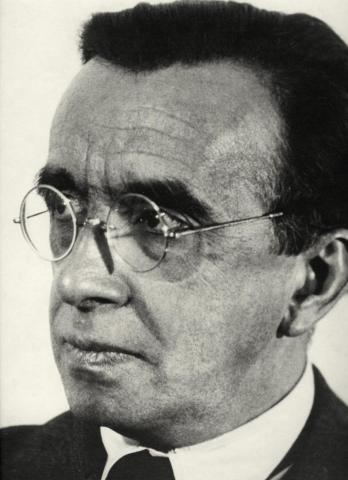Johann Nikolaus Richard Ernst, son of a businessman, went to school and university in Prague and obtained a doctorate in art history and classical archaeology in 1909. After working for a short time as a research assistant at the University of Prague Institute of Art History, he joined the k. k. Österreichische Museum für Kunst und Industrie (Imperial Royal Austrian Museum of Art and Industry) as an assistant curator and department head on 29 November 1911 and was responsible initially for metalwork. He served in the Austro-Hungarian army from 1915 to 1918. In the following years he took over the Court Silver and Table Room, the Glass and Ceramics Collection and the Carpet and Textiles Collection and in 1923 wrote the first guide to the Court Silver and Table Room and in 1925 a monograph on the Bloch-Bauer collection of Viennese neoclassicist porcelain. In 1928 he was appointed deputy director. From 1931 he was temporary director of the museum while director August Schestag was on sick leave and was officially appointed director on 5 August 1932. From February 1936 he was also an expert for old applied art in the Dorotheum but withdrew in January 1938 on account of differences of opinion with the auction house management. Parallel to the World's Fair in 1937, Austria was represented at an exhibition in the Musée du Jeu de Paume in Paris, at which Ernst curated the Austrian applied arts section, with loans from the porcelain collections of Ferdinand Bloch-Bauer, Anton Redlich and Franz Ruhmann. While the works of Oskar Kokoschka were being disavowed at the 1937 Nazi propaganda exhibition of "degenerate" art in Munich, Ernst made the Austrian Museum available in the same year for an exhibition commemorating the artist's fiftieth birthday. After the annexation, Ernst was accused of being politically unreliable for that reason, but his position as director of the Staatliches Kunstgewerbemuseum in Wien (State Arts and Crafts Museum in Vienna) as it was called from May 1938 was not really in jeopardy. He was well established in Vienna and internationally and had been praised by Robert Schmidt, director of the Schlossmuseum in Berlin, and Adolf Feulner, director general of the Arts and Crafts Museums in Cologne. Until 1945, Ernst worked on behalf of the Nazi regime to enlarge the collection of the Kunstgewerbemuseum through the addition of many objects from expropriated or forcibly sold collections, making use of his knowledge of private collections in Vienna. At the same time, for example, he supported Hans Ankwicz-Kleehoven, head of museum library, who had been forced to retire for "racial" reasons, by giving him access to an office. From February 1940, Ernst was also temporary director for two years of the Sculpture and Applied Arts Collection, now the Kunstkammer, in the Kunsthistorisches Museum in Vienna, during which time he organized an exchange of applied art and antique objects planned since the 1920s between the Kunsthistorisches Museum and the Staatliches Kunstgewerbemuseum. He even managed to obtain special funding of 250,000 Reichsmarks in foreign exchange for purchases from the museums in Italy. On two trips to Florence, Pisa, Rome and Bologna in spring and autumn 1942 he acquired sixteen pieces of Renaissance furniture. Reports issued immediately after the war that Ernst had also been in France on behalf of Reichsleiter Rosenberg and in the Netherlands for Mühlmann's department have not been verified to date. He claimed that, together with museum staff and a resistance group, he prevented the storage of arms and explosives in the museum at the end of March/start of April 1945 and the blowing up of the Stubenbrücke on 7 April 1945.
Ernst remained director in the re-established Republic of Austria. In the course of investigations by the Austrian state police in 1946, Ernst denied being a member of the NSDAP. On the contrary, he had been enrolled "unasked" in 1943 into the Reichsbund der Deutschen Beamten (Reich Federation of German Civil Servants) and his opposition to the NSDAP before and after 1938 was well known. Immediately after the end of the fighting in Vienna on 16 April 1945, Ernst inaugurated the repair of bomb-damaged museum, which was not completed until the early 1950s. Between 1945 and 1948, he also had the important tasks of recovering and restituting objects that had been stored to protect them from air raids. The lists drawn up from 1946 to 1948 in accordance with the Vermögensentziehungs-Anmeldungsverordnung (Property Expropriation Registration Regulation) and on behalf of the Allied Council included practically all objects that the museum had acquired during the Nazi era from expropriated collections. Ernst not only supported collectors known personally to him in the restitution of expropriated objects acquired by the Kunstgewerbemuseum but also helped to locate further items. In other cases, however, he followed the practice of the time of returning objects but disallowing their export and safeguarding them in this way for Austrian museums. On 31 March 1949, Ernst officially opened the Österreichisches Museum für angewandte Kunst (Austrian Museum of Applied Arts) as it was called after 1947. In 1950 an exhibition of major art from Austrian monasteries was the last one under his direction. He retired on 31 December 1950.

